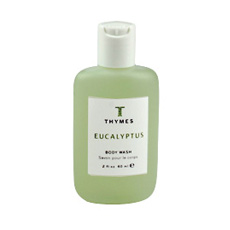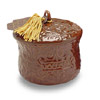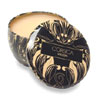The Thymes Eucalyptus 2 oz. Travel Size |
The Thymes Ginger Milk |
The Thymes Mandarin Coriander |
Voluspa Cocoa Tamarind Ceramic Tulip-Shaped Candlepot 7.5 oz. |
Voluspa Cocoa Tamarind EDP 4.5 oz. |
Voluspa Corsica Travel Candle |
(I've got to support my research
somehow and this ^ is how I do it.)
|
Are There
Aether Atoms?
|
|
| Yes, but they are not what you might expect. Wherever a massive object goes, in our universe, space is "curved" in its neighborhood. After the object leaves this neighborhood -- loosely speaking -- the space previously occupied reverts to its original state of flatness. I.e., space seems to have an elastic property. Elasticity however, as it is currently understood, is a result of electromagnetic interaction, which in turn is related to the constituents of material atoms. Additionally, wave propagation in solids, liquids and gasses depends on the presence, and electromagnetic properties, of atoms. A wavelike behavior is also characteristic of light. It seems like a reasonable guess that ‘the atoms of aether’ might exist and provide the underlying substrate that somehow (at the very least) implements the elasticity required for both gravity and light. There is something of a "mind-bender" here though. Our current atomic models place particles in space. The aether however, is space. Now, if it is space how can the atoms of aether move? What substrate could possibly provide the space for the aether atoms to move through? Is it possible that there is a superspace that serves as the container space for aether atoms? There are some scientists that think that this might be the case. ( listen to NPR to hear what one scientists says. A discussion of this broadcast can be found at: http://www.dejanews.com in the newsgroup: sci.physics.research, titled ‘The dangers of vacuum decay’.) (also see the GR bible: Misner, Thorne and Wheeler, ‘Gravitation’ the chapter on ‘Superspace’) Along these lines, one might further wonder, "What contains the superspace and what contains the super-superspace etc. etc…?" . Then… "Does each spatial context require a sub/super-context?" Or "How many spatial contexts are there?" Or "Is the universe, fundamentally heirarchical?" Or "Is the universe recursive?" … To address this group of questions I took a shortcut and asked the question "Is the universe derived from one existent (the space-time continuum?) or is it composed of n-existents" (The question allows the possibility of some kind of hierarchy.. ) If you look around you it seems fairly plausible that there are n-existents. The next step I took was to do a simple thought experiment: strip away all objects from the universe except one. Then ask "does this existent have a boundary?". Answer: no. It can’t have a boundary since it is all that exists. There is nothing outside of existence, no other and/or different object that might define a boundary. If I repeat this thought experiment for any other ‘kind’ of existent – same result Fundamental existents do not have boundaries. Now, if you add a second existent, does it somehow introduce a boundary? Ans: no. If there was no "outside" of one object, I can’t place a second object outside of the first. They have to intersect in some manner which does not include boundaries! I decided to try some dynamic geometry to represent the interactions of these objects. And… well to make a long story short (see: http://www.martinelli.org for the long story) … I derived a few equations that bear a remarkable similarity to some of the most fundamental equations known to physics. But, the one that is most relevant to the question of the existence of the aether atom, has the form: (const)(frequency)=(parameter)(const velocity)2. This equation looks like Einstein’s easily recognized hf=mc2. The reason that this is so compelling is that, in modern physics, Einstein's equation is taken as fundamental or ‘axiomatic’ – i.e., underivable. In his approach, Einstein reasoned that energy in any form (kinetic, thermodynamic, electric etc. ) is just plain old energy and so, the energy that Planck had discovered (E=hf) must be the same as his expression; E=mc2. Here, in contrast to Einstein’s method, the model for the ‘aether atom’, yields the equation explicitly. Another bit of convincing evidence is that this existent, when examined in the presence of i (and j) others of the same kind, produces a field equation. This equation has the form: Force=k1*i*j/(k2 + k3*r^2) (1) A plot of this equation yields a solitonic form – a wave of causality. In addition, when r is large (for an electron, ‘large’ means > 10e-15M), the constant k2 becomes insignificant and the equation becomes equivalent to: Force=k4*i*j/r^2 (2) The classical form for a field. Another characteristic of interest is that with a very small r, equation (1) becomes constant. That is, in the neighborhood of r=0, space is flat – there is no singularity in this field that might serve as an exact geometric point. Without this point, the object does not have a well defined center – in a physical/causal sense. Consequently, as a physical measuring device (e.g., bouncing off of electrons), this object will yield numbers that reflect this lack of exactness. The behavior is consistent with a well known problem in modern physics called the measurement problem. Furthermore, applying the principles of this theory in an electrostatic context, again in the presence of several other "aether atoms" and electrons, yields an equation that looks exactly like Neils Bohr’s equation for atomic spectra. In other words, these fundamental existents -- the constituents of empty space -- behave like photons. That is, we have a theory and physical evidence consistent with (and supporting) the theory. The theory, however, is far from complete. Among several other missing pieces, it doesn’t show how this aether is related to gravitation. If these atoms of aether are the constituents of empty space, then they should also somehow account for gravity. This piece is still under consideration. |
||
|
||
This page sponsered by: The Thymes Beautifully scented body lotions, candles, colognes and other bath and body products!






